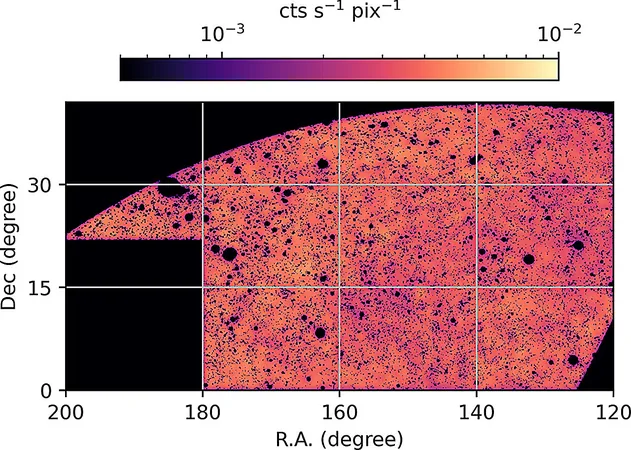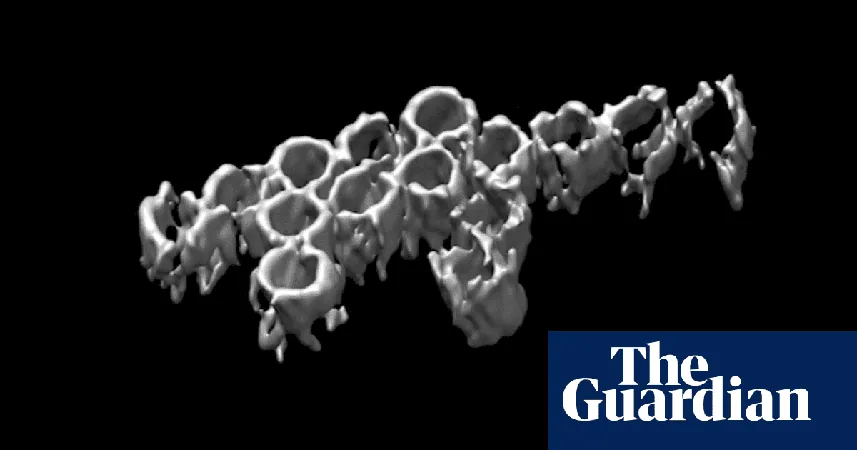
Unveiling the Secrets of the Intergalactic Medium: How Cosmic Filaments Shape Our Universe
2024-11-27
Author: Yan
Did you know that a staggering amount of the universe's mass exists not in stars or galaxies but in the vast expanses between them? This elusive matter resides in what astrophysicists call the intergalactic medium (IGM), specifically the warm-hot intergalactic medium, or WHIM. Recent scientific breakthroughs highlight its significance, revealing that WHIM accounts for roughly 50% of the universe's baryonic mass, yet it remains one of the least understood components in astrophysics!
The WHIM is not just empty space; it is a dynamic world filled with hot, diffuse gas, predominantly ionized hydrogen, existing at temperatures ranging from an astonishing 100,000 to 10 million Kelvin. This gas forms an intricate “cosmic web,” characterized by sprawling structures known as cosmic filaments. Stretching between galaxies, these filaments have been observed to measure 150 to 250 megaparsecs in length—equivalent to an incredible 500 to 800 million light-years! To put that into perspective, they are roughly 8,000 times wider than our Milky Way galaxy!
Cosmic filaments act as the connecting threads in the grand tapestry of the universe, forming the boundaries around cosmic voids—massive expanses with nearly no galaxies. These voids can exhibit an atom density of about one atom per cubic meter, making them more vacuous than even the vast spaces between stars in our galaxy.
A recent study led by a team of European scientists leveraged data collected by the eROSITA X-ray instrument aboard the Russian-German Spectrum Roentgen Gamma satellite. Launched in July 2019, eROSITA embarked on an ambitious endeavor to map the entire sky over seven years. However, after Russia's invasion of Ukraine in February 2022, the instrument ceased data collection. Despite this setback, the team analyzed X-ray emissions from nearly 8,000 cosmic filaments, significantly enhancing our understanding of WHIM.
These groundbreaking investigations employed multi-layered imaging techniques, capturing X-ray profiles within the 1 kilo-electronvolt spectrum. By referencing a catalog from the Sloan Digital Sky Survey that details over 63,000 filaments, and assuming established cosmological parameters, researchers were able to calculate the physical attributes of these filaments.
Through rigorous data analysis, they uncovered vital information about WHIM's average temperature, measuring approximately 7 million Kelvin. Additionally, they uncovered a baryon density contrast—essentially the density of baryonic matter relative to the average density—of 76. This suggests that the densities of matter in the WHIM are 76 times greater than the background density in space, aligning well with numerical simulations.
However, researchers noted that their temperature calculations hovered near the upper limits of known WHIM temperatures, likely influenced by the multi-temperature nature of cosmic gas.
As we continue to explore the mysteries of the cosmos, future X-ray missions such as the Hot Universe Baryon Surveyor and Line Emission Mapper promise to unlock even more secrets of the WHIM. By probing deeper into the properties of cosmic filaments and enhancing our understanding of the X-ray emissions from galaxy groups and active galactic nuclei, scientists are poised to shine a brighter light on this intriguing aspect of our universe.
Prepare for a new era of cosmic discovery that could reshape our understanding of the intergalactic medium! Stay tuned as we report on these developments and more. The universe is full of surprises, and we’re just getting started!


 Brasil (PT)
Brasil (PT)
 Canada (EN)
Canada (EN)
 Chile (ES)
Chile (ES)
 España (ES)
España (ES)
 France (FR)
France (FR)
 Hong Kong (EN)
Hong Kong (EN)
 Italia (IT)
Italia (IT)
 日本 (JA)
日本 (JA)
 Magyarország (HU)
Magyarország (HU)
 Norge (NO)
Norge (NO)
 Polska (PL)
Polska (PL)
 Schweiz (DE)
Schweiz (DE)
 Singapore (EN)
Singapore (EN)
 Sverige (SV)
Sverige (SV)
 Suomi (FI)
Suomi (FI)
 Türkiye (TR)
Türkiye (TR)